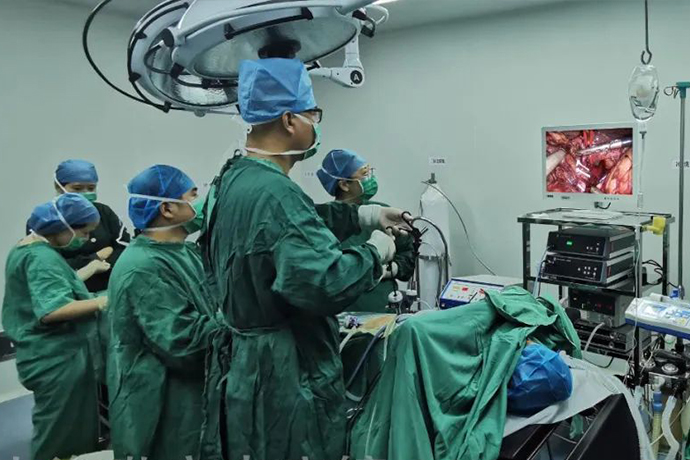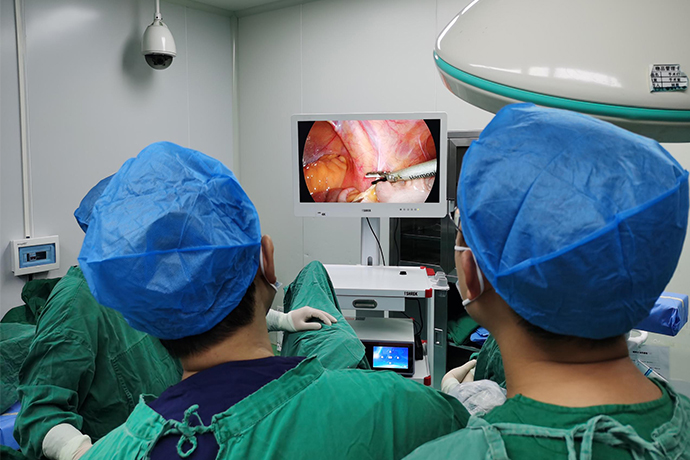【Laparoscopic Hepatobiliary Surgery】Pancreatoduodenectomy
Release time: 21 Feb 2023 Author:Shrek
Pancreaticoduodenectomy (OPD) is a common operation in hepatobiliary surgery, and it is suitable for tumors in the middle and lower segments of the common bile duct, head and neck of the pancreas, duodenal papilla, and duodenal space-occupying tumors.
The scope of the operation requires resection of part of the stomach, duodenum, head and neck of the pancreas, common bile duct, gallbladder and part of the jejunum, followed by reconstruction of the digestive tract through pancreaticojejunostomy, cholangioenterostomy, and gastrointestinal anastomosis. Due to the complexity of the operation and many organs involved, serious complications such as pancreatic leakage, bile leakage, infection, bleeding and even death are prone to occur after operation. It is reported that the postoperative mortality rate of this operation is about 5-6%.

The traditional pancreatoduodenectomy is to make a 25-30cm long anti-"L" incision in the right upper abdomen or make a 25cm long longitudinal incision along the right rectus abdominis. The advantage of this operation is that the exposure is clear and it can be operated under direct vision; the disadvantage is that the trauma is large, the patient suffers a lot, and the postoperative recovery is slow. Laparoscopic pancreatoduodenectomy (LPD) can well make up for the defects and deficiencies of OPD. The patient can eat and get out of bed on the second day after the operation, remove the abdominal drainage tube in 3 to 5 days, and leave the hospital in 7 days, which greatly reduces the pain of the patient, shortens the length of hospital stay, and reduces the cost of hospitalization!
Laparoscopic pancreatoduodenectomy (LPD) is one of the most difficult abdominal operations, requiring high surgical skills and teamwork. Among them, due to the deep anatomy of the uncinate process and the difficulty in exposure, the treatment of the uncinate process is a difficult point in LPD; the complete resection of the uncinate process and the pancreatic mesentery is the key to LPD. By exploring, improving, and optimizing the LPD surgical path and technical details, on the basis of multi-angle arterial approach, the middle and left posterior combined approach is used to accurately treat the key vessel in situ—inferior pancreaticoduodenal artery (IPDA) , to achieve safe and complete resection of the uncinate process and mesentery. This technique can adapt to uncinate process resection with different difficulties, and conforms to the "No touch" concept of tumor surgery.
Pancreaticoduodenectomy is the standard surgical procedure for tumors in the pancreatic head and ampulla. This operation removes many organs and tissues, has a wide range of lymphatic dissection, and complicated reconstruction of the digestive tract. It needs to go through "four cuts and three kisses". It is recognized by general surgery as the most complicated large-scale operation.
Brief steps of the operation
1. Explore the abdominal cavity, open the gastrocolic ligament, free the lower border of the pancreas, and make a Kocher incision.
2. Suspension of the liver. Routinely suspend the liver to facilitate the exposure space and biliary-enteric anastomosis, and the falciform ligament can be fixed by liver needle suspension or clips.
3. The stomach was cut off, the lymph nodes around the common hepatic artery were removed, and the GDA was ligated.
Lift the gastric body, use an ultrasonic scalpel to open the avascular area of the gastrocolic ligament, and divide it upward along the gastroepiploic vessels to the confluence of the left and right gastroepiploic vessels.
The gastric body was cut off near the confluence of the left and right gastroepiploic veins using a cutting closure. Pay attention to the protection of the left gastric vessel.
4. Cut off the jejunum, cut off the pancreas, cut off the pancreatic duct, and cut off the uncinate process of the pancreas.
5. Suspend the common hepatic artery and portal vein in turn.
6. Remove the gallbladder and cut off the common bile duct.
7. Free specimens and bag them.
8. Pancreaticojejunostomy, cholangioenterostomy, indwelling T tube. Gastrointestinal anastomosis and reinforcement suture on the inner wall of the anastomosis.
9. Place abdominal drainage tubes: anterior pancreaticojejunal drainage tube, posterior pancreaticojejunal drainage tube, Venturi hole drainage tube.

- Recommended news
- 【General Surgery Laparoscopy】Cholecystectomy
- Surgery Steps of Hysteroscopy for Intrauterine Adhesion
- [Gynecological Hysteroscopy] Techniques for Preventing and Treating Complications of Hysteroscopic Surgery
- [Gynecological Hysteroscopy] Hysteroscopic Adhesiolysis
- [Gynecological Hysteroscopy] IUD Removal under Hysteroscopy